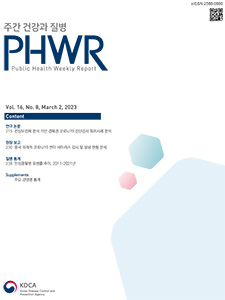Current Issue
Vol.16 No.8, March 02, 2023
-
Original Articles 2023-03-02
 0
0
 1122
1122
 228
228
Characterization of COVID-19 Diagnosis Based on Whole Genome Sequencing in Gyeongbuk Region
Haesun YUN, Jeonjoo Park, Hagyeong Chae, Hyo-Jin Kim, Seong Hee Oh, Yong-Pyo Lee, Gyeong Ran Moon, Chang-kyu Sohn, Chang-il Lee, Wooyoung Choi
Public Health Weekly Report 2023; 16(8): 215-229 https://doi.org/10.56786/PHWR.2023.16.8.1AbstractIn order to analyze the differences between the results of coronavirus disease 2 019 (COVID-19) diagnostic tests in Gyeongbuk, Republic of Korea, this study was performed full length genome analysis of severe acute respiratory syndrome coronavirus 2 (SARS-CoV-2) used by Ion Torrent Genexus Integrated Sequencer and dedicated analysis program. Full-length genomic sequences of the SARS-CoV-2 were obtained from specimen of 13 confirmed cases of COVID-19. As a result of the analysis, the Omicron sub-lineages were BA.1.1 (n=5), BA.2 (n=4), and BA.2.3 (n=4). In detail, R61C or R61H were confirmed in the E gene, meanwhile L142W and 166–178 nucleotide sequences were deleted in the ORF1ab NSP3 region. In the analysis using a computer program, mutations in the E gene region (R61H) were not useful as a target region for COVID-19 Real-time RT-PCR. Amino acid mutation (L142W) and nucleotide deletion (166–178) in the ORF1ab NSP3 region have been identified to affect diagnosis of COVID-19 with specific diagnostic kits. Thus, these results suggest that the detailed lineage and genetic mutations of the SARS-CoV-2 using the whole genome sequencing could be a critical tool for the COVID-19 diagnosis.
-
Notes from the Field 2023-03-02
 0
0
 1342
1342
 329
329
Surveillance and Outbreak Status of SARS-CoV-2 Originated from China
Jeong-Ah Kim, Il-Hwan Kim, Jin Sun No, HyeokJin Lee, Chae Young Lee, Eun-Jung Lee, Sahyun Hong, Kyu-Sik Chang, Jee Eun Rhee, Jeong-Gu Nam, Eun-Jin Kim
Public Health Weekly Report 2023; 16(8): 230-237 https://doi.org/10.56786/PHWR.2023.16.8.2 Abstract
AbstractThe Korea Disease Control and Prevention Agency (KDCA) is conducting variant analysis through whole genome analysis to strengthen quarantine measures for confirmed cases of coronavirus disease 2019 arriving from China, as the number of confirmed cases in China has increased since December 2022. The BA.5 subvariants, which include BA.5 and BF.7, have been identified in >90% of confirmed cases of Chinese origin by Korea Respiratory Virus Integrated Surveillance System. An examination of Chinese-origin genetic data shared by China and other countries in the Global Initiative for Sharing All Influenza Data confirms similar findings, indicating that BA.5 subvariants, including BA.5 and BF.7, are currently predominant in China, accounting for >90% of cases. To date, no variants of significant concern have been identified. However, as the number of confirmed cases in China rises, the KDCA will continue to conduct enhanced mutation surveillance to detect the introduction and/or domestic emergence of new variants. In addition, the KDCA will strengthen international cooperation by actively sharing relevant information.
-
QuickStats 2023-03-02
 2
2
 1734
1734
 329
329
Trends in the Prevalence of Chronic Kidney Disease, 2011–2021
Public Health Weekly Report 2023; 16(8): 238-239 https://doi.org/10.56786/PHWR.2023.16.8.3

pp. 1433~1461
Most Keyword
?
What is Most Keyword?
- It is the most frequently used keyword in articles in this journal for the past two years.
Most Read
-
Waterborne and Foodborne Disease Outbreaks in the Republic of Korea, 2023
Myung-Jae Hwang, So Yeon Park, Hyungjun Kim, Se Jeong Yang, Sungchan Yang, Jin Seon Yang
Public Health Weekly Report 2025;18: 17-32 https://doi.org/10.56786/PHWR.2025.18.1.2 -
Implementation Plan for the Coronavirus Disease 2019 Vaccination for the 2024–2025 Season: Recommendations of the 6th Expert Committee on Immunization Practices
Hyewook Hwang, Wookeon Lee, Seohyeon Ahn, Young-Sook Choi, Seunghyun Lewis Kwon, Dongwoo Lee, Eun Hwa Choi, SokGoo Lee
Public Health Weekly Report 2025;18: 90-102 https://doi.org/10.56786/PHWR.2025.18.2.3
Editorial Office
+82-43-719-7569





 Full Text
Full Text Cite
Cite


